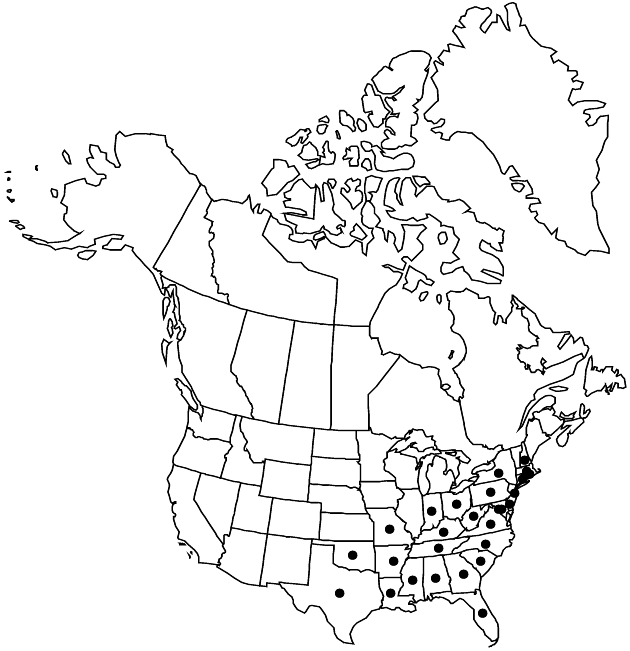Difference between revisions of "Eupatorium rotundifolium"
Sp. Pl. 2: 837. 1753.
FNA>Volume Importer |
RevisionBot (talk | contribs) m (Bot: Adding category Revised Since Print) |
||
| (8 intermediate revisions by 3 users not shown) | |||
| Line 8: | Line 8: | ||
}} | }} | ||
|common_names=Roundleaf thoroughwort | |common_names=Roundleaf thoroughwort | ||
| + | |special_status={{Treatment/ID/Special_status | ||
| + | |code=E | ||
| + | |label=Endemic | ||
| + | }} | ||
|basionyms= | |basionyms= | ||
|synonyms= | |synonyms= | ||
| Line 20: | Line 24: | ||
-->{{Treatment/Body | -->{{Treatment/Body | ||
| − | |distribution= | + | |distribution=Ala.;Ark.;Conn.;D.C.;Del.;Fla.;Ga.;Ind.;Ky.;La.;Mass.;Md.;Miss.;Mo.;N.C.;N.H.;N.J.;N.Y.;Ohio;Okla.;Pa.;R.I.;S.C.;Tenn.;Tex.;Va.;W.Va. |
|discussion=<p>Varieties 3 (3 in the flora).</p><!-- | |discussion=<p>Varieties 3 (3 in the flora).</p><!-- | ||
| − | --><p>Eupatorium rotundifolium is one of the more variable species of the genus; its apparent propensity to hybridize with other species has led it to be described as a compilospecies and has complicated its delimitation. Hybrids with E. perfoliatum and E. sessilifolium are sufficiently distinctive to be treated here as distinctive entities (E. ×cordigerum and E. godfreyanum, respectively), and the varieties ovatum and scabridum have also been proposed to be of hybrid origin. The boundaries between varieties are indistinct and individual specimens may be difficult to place with confidence.</p> | + | --><p><i>Eupatorium rotundifolium</i> is one of the more variable species of the genus; its apparent propensity to hybridize with other species has led it to be described as a compilospecies and has complicated its delimitation. Hybrids with <i>E. perfoliatum</i> and <i>E. sessilifolium</i> are sufficiently distinctive to be treated here as distinctive entities (<i>E. ×cordigerum</i> and <i>E. godfreyanum</i>, respectively), and the varieties ovatum and scabridum have also been proposed to be of hybrid origin. The boundaries between varieties are indistinct and individual specimens may be difficult to place with confidence.</p> |
|tables= | |tables= | ||
|references= | |references= | ||
| Line 53: | Line 57: | ||
-->{{#Taxon: | -->{{#Taxon: | ||
name=Eupatorium rotundifolium | name=Eupatorium rotundifolium | ||
| − | |||
|authority=Linnaeus | |authority=Linnaeus | ||
|rank=species | |rank=species | ||
| Line 60: | Line 63: | ||
|basionyms= | |basionyms= | ||
|family=Asteraceae | |family=Asteraceae | ||
| − | |distribution= | + | |distribution=Ala.;Ark.;Conn.;D.C.;Del.;Fla.;Ga.;Ind.;Ky.;La.;Mass.;Md.;Miss.;Mo.;N.C.;N.H.;N.J.;N.Y.;Ohio;Okla.;Pa.;R.I.;S.C.;Tenn.;Tex.;Va.;W.Va. |
|reference=None | |reference=None | ||
|publication title=Sp. Pl. | |publication title=Sp. Pl. | ||
|publication year=1753 | |publication year=1753 | ||
| − | |special status= | + | |special status=Endemic |
| − | |source xml=https:// | + | |source xml=https://bitbucket.org/aafc-mbb/fna-data-curation/src/2e0870ddd59836b60bcf96646a41e87ea5a5943a/coarse_grained_fna_xml/V19-20-21/V21_1183.xml |
|tribe=Asteraceae tribe Eupatorieae | |tribe=Asteraceae tribe Eupatorieae | ||
|genus=Eupatorium | |genus=Eupatorium | ||
| Line 71: | Line 74: | ||
}}<!-- | }}<!-- | ||
| − | -->[[Category:Treatment]][[Category:Eupatorium]] | + | --> |
| + | |||
| + | [[Category:Treatment]] | ||
| + | [[Category:Eupatorium]] | ||
| + | [[Category:Revised Since Print]] | ||
Latest revision as of 18:26, 6 November 2020
Perennials, 40–100+ cm. Stems (from short rhizomes) single, sparsely branched distally, puberulent. Leaves usually opposite (distal sometimes alternate, lateral buds dormant or producing 1 pair of leaves); sessile or subsessile; blades ± 3-nerved, usually ± deltate to orbiculate, sometimes ovate, 15–50(–70) × 15–40(–60) mm (lengths mostly 1–2 times widths), bases broadly rounded to truncate, margins crenate to serrate, apices acute, faces puberulent to villous, gland-dotted. Heads in corymbiform arrays. Phyllaries 8–10 in 2–3 series, elliptic to oblanceolate, 2–6 × 0.5–1.5 mm, apices acute, abaxial faces puberulent, gland-dotted. Florets 5; corollas 3–4 mm. Cypselae 2–3 mm; pappi of 30–40 bristles 3.5–4 mm.
Distribution

Ala., Ark., Conn., D.C., Del., Fla., Ga., Ind., Ky., La., Mass., Md., Miss., Mo., N.C., N.H., N.J., N.Y., Ohio, Okla., Pa., R.I., S.C., Tenn., Tex., Va., W.Va.
Discussion
Varieties 3 (3 in the flora).
Eupatorium rotundifolium is one of the more variable species of the genus; its apparent propensity to hybridize with other species has led it to be described as a compilospecies and has complicated its delimitation. Hybrids with E. perfoliatum and E. sessilifolium are sufficiently distinctive to be treated here as distinctive entities (E. ×cordigerum and E. godfreyanum, respectively), and the varieties ovatum and scabridum have also been proposed to be of hybrid origin. The boundaries between varieties are indistinct and individual specimens may be difficult to place with confidence.
Selected References
None.
Lower Taxa
Key
| 1 | Leaf blades 3-nerved from bases, bases subtruncate to broadly cuneate, margins crenate | Eupatorium rotundifolium var. rotundifolium |
| 1 | Leaf blades 3-nerved distal to bases, bases broadly cuneate to cuneate, margins serrate | > 2 |
| 2 | Leaf blades 30–70 × 30–60 mm, broadest nearmiddles | Eupatorium rotundifolium var. ovatum |
| 2 | Leaf blades 20–50 × 15–30 mm, broadest nearbases | Eupatorium rotundifolium var. scabridum |